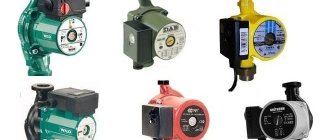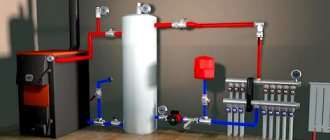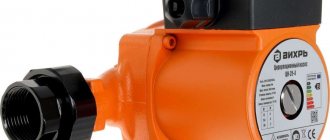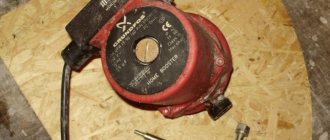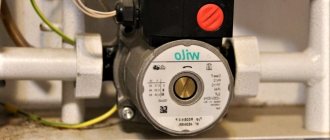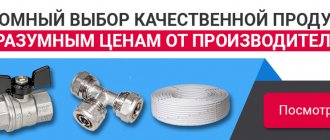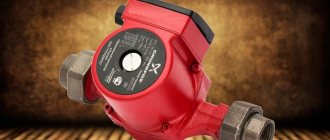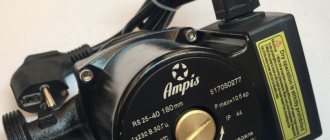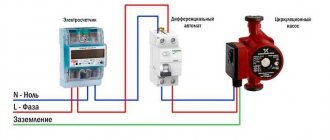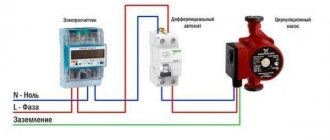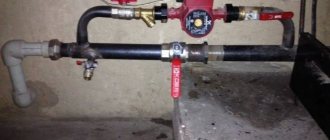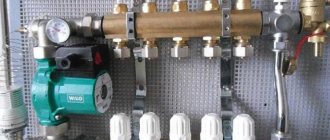Despite the widespread use of heating systems with natural coolant circulation, they have a number of serious disadvantages. These include the low speed of fluid movement, which negatively affects the final temperature in the return circuit. It should also be mentioned that not all radiators receive the same amount of hot water. Such shortcomings do not allow the house to be provided with sufficient heat.
However, today this problem can be solved if the heating system operates in combination with a circulation pump . Here the problem arises: which one to choose? If you turn to specialists, then, in their opinion, the best option among all the options offered is the Grundfos UPS pump.
Who makes Grundfos pumps
Grundfos household circulation pumps are manufactured in the company's own factories, whose activities date back to 1945. The word Grundfos literally translates as “spring” was not chosen by chance. Grundfos produces pumping equipment for wells, heating systems, etc.
About 16 million units of equipment are produced annually, which corresponds to approximately 50% of all pumping equipment produced in the world. Grundfos models are used for private and industrial purposes, installed in mines and mines, and used for the extraction of mineral and thermal waters. Pumping equipment is operated in extremely unfavorable conditions.
One of the company's latest trends has been the widespread introduction of energy-saving technologies, which can significantly reduce energy consumption while maintaining the performance and reliability of equipment.
history of the company
The starting point for Grundfos should be considered 1945.
It was then that, on the initiative of the Danish engineer Paul Du Jensen, a small production was founded, which was called “Bjerringbro Pressestoberi og Maskinfabrik”. If you try to translate it, in Russian it will sound like the Bjerringbro injection molding and machining factory. During the first years of the company’s operation, the engineer devoted all his efforts to the creation and production of only one product - pumping equipment. Thanks to the high quality of the products, as well as a non-standard approach to solving most problems regarding design features and dimensions, it did not take the company very long for the manufactured units to become highly popular. As production capacity increased, more and more consumers chose products under this brand.
Until 1967, the company changed its name several times. And only this year the name Grundfos was assigned to it, by which today the manufacturer of high-quality pumps is recognized.
If we look at world statistics, then the share of pumping equipment manufactured under the Grundfos brand accounts for about 50% of global consumption. The reasons for this situation are not only related to high quality. This was also facilitated by the fact that the company today represents an international concern. In many countries there are plants, factories and small assembly shops created on the initiative of Grundfos management. They are also available in our country. Thus, in the Russian capital in 1992, a representative office of the company appeared , which later received the status of a subsidiary, the first decision of which was to launch a plant near the city of Istra.
Types of Grundfos water pumps
Grundfos heating circulation pumps are available in several basic modifications. Models can be divided into two groups:
- Circulation pump for hot water.
- Equipment designed to be connected to a heating system.
Some models are universal and can simultaneously connect to radiator heating systems, heated floors and hot water supply.
Installing a Grundfos circulation pump of the required modification will completely solve the issue of automation of the heating and hot water supply system.
The scope of application of Grundfos pumping equipment is not limited solely to domestic needs. The main directions are:
- Creation of a heating system for an apartment building.
- Installation for a private home, regardless of the type of water heating equipment and the type of fuel used.
- Installation in cooling and air conditioning systems.
- Connection to heated floors, radiators and heated towel rails.
- Industrial building.
Heating pumps Grundfos
For heating systems with forced circulation of coolant, the optimal choice is to install circulation equipment of one of the following modifications:
- Grundfos Alpha2 is one of the innovative models with a built-in electronic control unit. Circulation pumps for Grundfos heating and hot water supply Alpha2 have the following advantages: automatic adaptation to existing needs and system configuration, the ability to simultaneously connect to several water circuits. There is a built-in frequency converter. The daily electricity consumption of the Grundfos Alfa2 circulation pump, compared to models with a mechanical regulator, is reduced by 2-3 times. Capacity 3 m³/hour, water column head 6 m.
Alpha2 L - a distinctive feature of the model is the presence of a built-in frequency converter, a technology that uses the principle of permanent magnets. The Alpha2 L is controlled by pressing a single button. The pump control unit automatically selects the required mode, depending on the number of connected circuits. The design provides thermal protection. In the event of a power outage, the pressure relief valve is activated, preventing the coolant from boiling.
Alpha3 – pumps for water circulation in the heating system. They have a cast iron body. There are modifications intended for use in hot water supply. The housing of models for domestic hot water supply is made of stainless steel. The electronic control unit automatically adapts to the heating system. The Grundfos Alpha3 circulation pump design includes a function that prevents idling, a built-in air vent, and an indicator panel. The screen provides information about pressure and energy consumption. The model uses an innovative “summer mode” function. Automatic parameter adjustment reduces power consumption. Average consumption from 3 to 50 W.
Magna 1 – frequency controlled pump. An electronic control unit is installed. Magna 1 flanged pumps are suitable for domestic and industrial purposes. Nine fixed control modes are supported, and an automatic diagnostic system is present. Maximum pressure 16 bar. Dry running protection is provided. The pump is cooled by natural ventilation. The series also includes dual circulation pumps Grundfos Magna 1. Their use is convenient when connecting several circuits at the same time, or using one of the engines as a reserve. The motor protection module prevents rotor failure due to voltage surges. There is no need to install a stabilizer.
Grundfos Magna3 - the series includes both small circulation equipment and industrial pumping stations with a throughput of 70 m³/hour, a water column head of up to 18 m, and a maximum pressure of 16 bar. As in previous versions of pumping equipment, Grundfos Magna3 is distinguished by its silent operation mode, as well as the presence of energy-saving technology. The control unit has three built-in modes: AUTOADAPT, FLOWADAPT and FLOWLIMIT. Thanks to three built-in functions, the automatic operation of the pump analyzes the system and selects the most economical mode. When night falls, the pumping equipment switches to maximum economy mode. The kit includes protective heat-insulating casings. The type of regulation is selected by pressing a key. According to the type of installation, Magna3 is flanged pumps.
Grundfos UPS - three-speed circulation pumps with mechanical control. The optimal solution for a private house or cottage. The models have a simple design. The body is made of cast iron, bearings are made of stainless steel. Grundfos UPS are wet-rotor pumps with coolant fluid acting as a lubricant. The series also includes models with a bronze body, designed to meet the needs of domestic hot water supply. The pump operating mode is selected independently, depending on the parameters of the heating system.
ALPHA1 L
This series of pumps has wider capabilities than UPS. They implement the ability to automatically adjust the shaft rotation speed, which allows the ALPHA1 L to be used as part of heating systems with a high degree of automation. Like all GRUNDFOS circulation pumps, the ALPHA1 L is characterized by very high energy efficiency, with an EEI coefficient of less than 0.23. This means very high efficiency. "L" in the index means limited functionality. Take a look at the list of pump capabilities - it is more than impressive, there are 6 modes in total. But GRUNDFOS calls this “limited functionality” for a reason, because the range includes models with even more diverse capabilities.
How to choose a Grundfos circulation pump
I would like to note right away that it is quite difficult to independently make calculations and select a pump that is optimally suited to an individual heating system. Company consultants and special online calculators can help you make your choice. As practice shows, the decision to purchase the model you like is most influenced by:
- Technical characteristics of Grundfos circulation pumps - you should pay attention to power, throughput and type of design.
- It’s a good idea to make sure that you are purchasing an original device and not a fake.
- Design features.
- Cost and service life of the module.
Circulation pumps for Grundfos heating systems are offered in five basic versions. Selection of equipment requires the involvement of a specialist. Below are recommendations from professional installation teams and consultants.
How to distinguish a fake pump from an original Grundfos
How to calculate the required power of a Grundfos pump
Cost of Grundfos pumps
The average cost per unit of pumping equipment varies from 5 to 80 thousand rubles. The cost of the model is influenced by several factors:
- Technical characteristics of circulation pumps for heating of the Grundfos brand. Performance, the presence of a twin electric motor, and an automatic control unit - all this increases the cost of the model.
- Additional equipment. After connecting the pump, the heating system becomes volatile and stops working after a power outage. To eliminate this drawback, you will need to connect an uninterruptible power supply. Installation to heated floors is carried out using a special mixing unit.
The high cost is justified when you consider that maintenance of circulation pumps for Grundfos heating systems is not required. The models will work throughout their entire service life without any complaints and will help to significantly save on electricity.
Service life of Grundfos pumps
Advantages
Careful selection of components and concern for product quality allowed the manufacturer to create a durable and economical pump. Some models (“Grundfos Alpha” and “UPE”) are additionally equipped with an automation system, which frees the owner from periodic monitoring and manual adjustment of settings.
Several sensors and temperature controllers will ensure periodic operation of the device. And when the specified parameters are reached, the Grundfos pump will automatically turn off. Another advantage of a circulation pump is that you can save not only fuel in the boiler, but also the electricity consumed by the device itself. Savings can be up to 60%. Periodic operation reduces the amount of hydraulic noise and increases comfort for the occupants of the house.
The rotor is separated from the stator by a steel plate, and is located in pipes. The Grundfos pump itself has compact dimensions, is easily mounted to the pipeline, and is also equipped with high-quality thermal insulation. Fastening is carried out using a threaded or flange method. At the request of the customer, the unit body can be made of various materials (stainless steel, bronze or cast iron).
All these advantages of Grundfos heating pumps, reliable equipment from a German manufacturer, do not make them unaffordable for the buyer.
How to install a Grundfos pump correctly
Detailed recommendations for installation and installation are contained in the technical documentation included in the basic equipment package. But as practice shows, the instructions are often turned to in the very last place, when a breakdown has already occurred.
Things to remember when installing a circulation pump in a heating system:
- The pump is placed on the return line, usually immediately after the expansion tank.
- It is prohibited to start the electric motor until the heating system is filled with coolant.
- The correct installation position of the pump is vertical. Only in this position does the coolant completely lubricate all rubbing parts: bearings, rotor. When turned on with a dry rotor, the pump quickly fails. The service life is reduced if the internal volume of the housing is not completely filled with coolant, as happens with horizontal installation.
- Correct installation of the Grundfos circulation pump in the heating system takes into account the operating features. So, in case of frequent power outages, they are connected to a UPS and also installed in a bypass.
- The procedure for installing the pump is as follows: install the water circuit. Afterwards, using “Americans” (included in the kit) or couplings, the pump is connected. The heating system is filling up. Now you need to remove air from the pump. To do this, use a screwdriver to unscrew a special bolt on the top cover covering the engine.
- Selecting the operating mode - the pump works best at minimum speed. In quiet mode, bearings and other mechanisms that are subject to load during operation wear out less. But, as a rule, the minimum speed is not enough. The device has three stages of pump rotation speed. It is worth choosing the mode in which the heating system is evenly heated. Models with an electronic control unit independently select the required circulation speed.
Circulation pumps of the Grundfos brand are known all over the world - they are the most common heating equipment.
The Grundfos concern began its history in the 1950s in Denmark as a small company developing and producing components for heating and water supply in the private sector. Today there are 75 enterprises in 42 countries .
Types of devices for heating systems
Grundfos pumps designed to operate as circulation pumps are divided into two main groups , the difference of which lies in the operating conditions of the drive motor rotor.
If only the pump impeller comes into contact with the pumped liquid, then this design is called “dry rotor”.
If the transported liquid contains both the impeller and the motor rotor, it is a pump with wet rotor characteristics.
Both types of construction have their own characteristics and areas of application.
Dry
The dry rotor is good high efficiency and high power. Pumps of this type are also little sensitive to the quality of the coolant and can easily tolerate contamination from suspended matter and fine abrasives. Operates at temperatures significantly higher than the permissible operating values of glandless rotor pumps.
Photo 1. Disassembled Grundfos circulation pump for a heating system, equipped with a dry rotor.
The disadvantages are a shorter service life, comparatively high cost, slightly larger size, the need for regular maintenance (lubrication), and high noise. For this reason, models with a dry rotor are best installed in a separate room. But at the same time, they are able to “pump up” large cottages or even apartment buildings.
Wet
The wet rotor is more compact, almost silent, and extremely durable when installed correctly. Does not require maintenance during operation, but is less productive, with a relatively low efficiency - no more than 50%.
With overall low power consumption (on average 6–100 W depending on power, mode and load), this characteristic is not decisive.
This type of pumping equipment is extremely sensitive to the quality of the pumped liquid, since it is both a lubricant and antifreeze for the rotor. Therefore, such devices cannot operate at temperatures above 115 degrees and require the installation of a mesh dirt filter in front of the pump.
Photo 2. Grundfos compact circulation pump with a wet rotor, sensitive to the quality of the pumped liquid.
Wet-type devices are widely used in individual heating and water supply systems as additional circulation pumps for the make-up line.
Circulation pumps are installed in heating systems with forced or natural circulation. It is needed to increase heat transfer and to be able to regulate the temperature in the room. Installing a circulation pump is not the most difficult task; if you have a minimum of skills, you can do it yourself, with your own hands.
What to pay attention to during installation?
A difficult point at the installation stage is the correct choice of the direction of the pipes.
However, there will be no problems with this due to the fact that the manufacturer has taken the necessary measures that will simplify the solution of this problem. If you look at the pump body, you can see an arrow corresponding to the rotation of the rotor. From it you can understand in which direction the coolant is moving. Please note that the circulation pump is sold without mounting hardware . Therefore, you will have to buy them separately. Having completed the installation of the circulation device, you should pause for a day, and then you can start the pump. This must be done for the reason that the operation of circulation pumping equipment must take place exclusively at positive indoor temperatures. If before purchasing the pump it was located or transported in the cold, then without natural heating of its component elements during startup there is a risk of its breakdown.
To connect the device to the AC network, it is advisable to use a separate cable separated from the distribution panel. If you use the Grundfos UPS 25-40 model, you can choose a three-core copper cable with a cross-section of one core of 0.75 mm2.
What is a circulation pump and why is it needed?
A circulation pump is a device that changes the speed of movement of a liquid medium without changing pressure. In heating systems it is installed for more efficient heating. In systems with forced circulation it is a mandatory element, in gravity systems it can be installed if it is necessary to increase the thermal power. Installing a circulation pump with several speeds makes it possible to change the amount of heat transferred depending on the outside temperature, thus maintaining a stable temperature in the room.
Cross-section of a circulation pump with a wet rotor
There are two types of such units - with a dry and wet rotor. Devices with a dry rotor have a high efficiency (about 80%), but are very noisy and require regular maintenance. Units with a wet rotor operate almost silently; with normal coolant quality, they can pump water without failure for more than 10 years. They have a lower efficiency (about 50%), but their characteristics are more than sufficient for heating any private home.
ALPHA2 AND ALPHA3
Now these pumps are completely identical in functionality. This happened after ALPHA2 had the opportunity to independently carry out hydraulic balancing of the heating system, which was previously only present in ALPHA3. This is a very convenient solution that has earned the informal nickname “Cure for the Cold.”
For hydraulic balancing you will need an ALPHA Reader, which is installed on the electronic unit. It must be purchased separately and is not included in the package. APLHA Reader transmits information from the pump to a smartphone or iPad. You will also need the free GRUNDFOS Go Balance application, which must be installed on your gadget. The further procedure is carried out under the guidance of the application, which will provide detailed instructions for each stage of hydraulic balancing of the entire system. The ALPHA2 and ALPHA3 pumps allow you to measure the coolant flow in any heating system (warm floor, two or single pipe systems, dead-end, radiator network without thermal heads or with a constant flow) on all radiators and underfloor heating circuits in real time. This allows you to reduce to zero possible errors, which cannot be avoided even with the most careful theoretical calculations.
However, ALPHA2 and ALPHA3 are interesting not only because of their ability to self-balance. These are modern multifunctional units that perform excellent work in different conditions. They have three fixed speed modes, three constant pressure drop modes and three proportional control modes - such a wide choice opens up the possibility of fine-tuning the system, the pump becomes universal. There are two more important additional functions: “night saving mode” and “summer mode”. In Denmark, where these pumps were developed, they are in great demand. Firstly, heating rooms that are unoccupied at night is simply irrational. Secondly, there is a question of compatibility. The pumps are suitable for use with modern boilers where a similar mode is present. Pragmatic Danes know a lot about saving; heating is generally an expensive pleasure for them. Therefore, burning gas, wood or coal in vain is an unaffordable luxury.
As for the “summer mode”, this is a seasonal function. It allows you to start heating in the fall without unnecessary problems. For example, souring of the pump shaft during a long period of inactivity. In fact, starting the system yourself several times during the summer is a real hassle. “Summer mode” will maintain the system’s functionality independently.
GRUNDFOS ALPHA2 was the first pump to feature the AUTOADAPT mode - naturally, ALPHA3 also “inherited” it. This is a new product from the company’s engineers, who pay great attention, first of all, to ease of use, and of course, energy efficiency. The function became a real breakthrough and a kind of standard for subsequent generations of circulation pumps. The AUTOADAPT mode makes it possible to automatically change equipment settings when the needs of people living in the house change, or, for example. Changes of seasons. Using complex software algorithms, the equipment electronics constantly analyzes the processes and, depending on the indicators, selects the optimal pressure. This significantly saves heating system resources and consumer money.
Now more than 3 million ALPHA series pumps are successfully operating around the world. GRUNDFOS has released an updated model, which has an even higher energy efficiency class and meets the high requirements of the European EuP standard. The average energy efficiency index (EEI) for ALPHA2 pumps is 0.15. At the moment this is the best indicator. ALPHA2 and ALPHA3 consume only 3 W in constant speed mode and 4 W in AUTOADAPT mode. This means that the pump requires 87% less energy than most analogues on the world market. They have a built-in electronic flow meter to simplify balancing and diagnostics of the heating system. They are also capable of operating at temperatures from 2 to 40 °C and even in environments that form condensation.
Harness
There are two types of heating systems - forced and natural circulation. Systems with forced circulation cannot work without a pump; systems with natural circulation work, but in this mode they have lower heat transfer. However, less heat is still much better than no heat at all, so in areas where electricity is often cut off, the system is designed as hydraulic (with natural circulation), and then a pump is installed into it. This gives high heating efficiency and reliability. It is clear that the installation of a circulation pump in these systems is different.
All heating systems with heated floors are forced - without a pump, the coolant will not pass through such large circuits
Forced circulation
Since a forced circulation heating system without a pump is inoperative, it is installed directly into the gap in the supply or return pipe (of your choice).
Most problems with the circulation pump arise due to the presence of mechanical impurities (sand, other abrasive particles) in the coolant. They can jam the impeller and stop the motor. Therefore, a mesh dirt filter must be placed in front of the unit.
Installing a circulation pump in a forced circulation system
It is also advisable to install ball valves on both sides. They will make it possible to replace or repair the device without draining the coolant from the system. Turn off the taps and remove the unit. Only that part of the water that was directly in this piece of the system is drained.
Natural circulation
The piping of the circulation pump in gravity systems has one significant difference - a bypass is required. This is a jumper that makes the system operational when the pump is not working. One ball shut-off valve is installed on the bypass, which is closed the entire time the pumping is running. In this mode, the system operates as forced.
Installation diagram of a circulation pump in a system with natural circulation
When the electricity goes out or the unit fails, the valve on the jumper is opened, the valve leading to the pump is closed, and the system operates as a gravity system.
Installation features
There is one important point, without which the installation of the circulation pump will require rework: it is necessary to rotate the rotor so that it is directed horizontally. The second point is the direction of flow. There is an arrow on the body indicating which direction the coolant should flow. This is how you turn the unit so that the direction of movement of the coolant is “in the direction of the arrow”.
The pump itself can be installed both horizontally and vertically, just when selecting a model, make sure that it can work in both positions. And one more thing: with a vertical arrangement, the power (pressure created) drops by about 30%. This must be taken into account when choosing a model.
